The Relationship Between CSR and Corporate Financial Performance
VerifiedAdded on 2019/11/25
|13
|3153
|149
Essay
AI Summary
This essay provides a comprehensive analysis of Corporate Social Responsibility (CSR) and its implications for corporate financial performance. It begins with an executive summary highlighting the importance of CSR in business operations, particularly concerning sustainability. The essay delves into organizations' adoption of CSR, examining the motivations behind it, such as enhancing a company's reputation and attracting a better workforce. It then explores the Stakeholder Theory, emphasizing the need for businesses to balance the interests of various stakeholders. The paper also discusses the potential drawbacks of CSR, including increased costs and customer cynicism. The essay concludes with a discussion on how businesses can measure their CSR financial performance, offering valuable insights for businesses aiming to integrate CSR into their strategies. The essay references multiple sources to support its arguments and provide a well-rounded perspective on the subject.
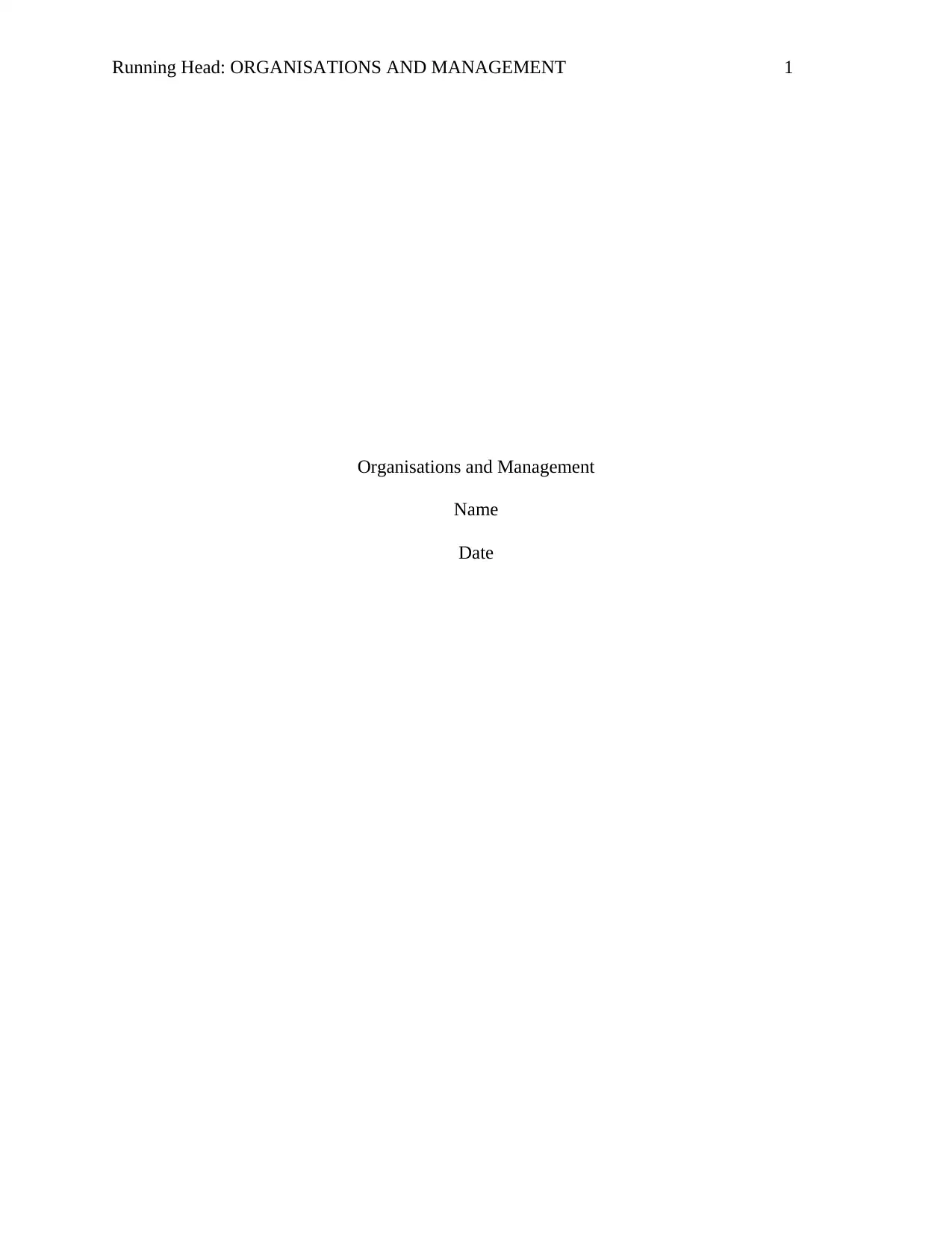
Running Head: ORGANISATIONS AND MANAGEMENT 1
Organisations and Management
Name
Date
Organisations and Management
Name
Date
Paraphrase This Document
Need a fresh take? Get an instant paraphrase of this document with our AI Paraphraser
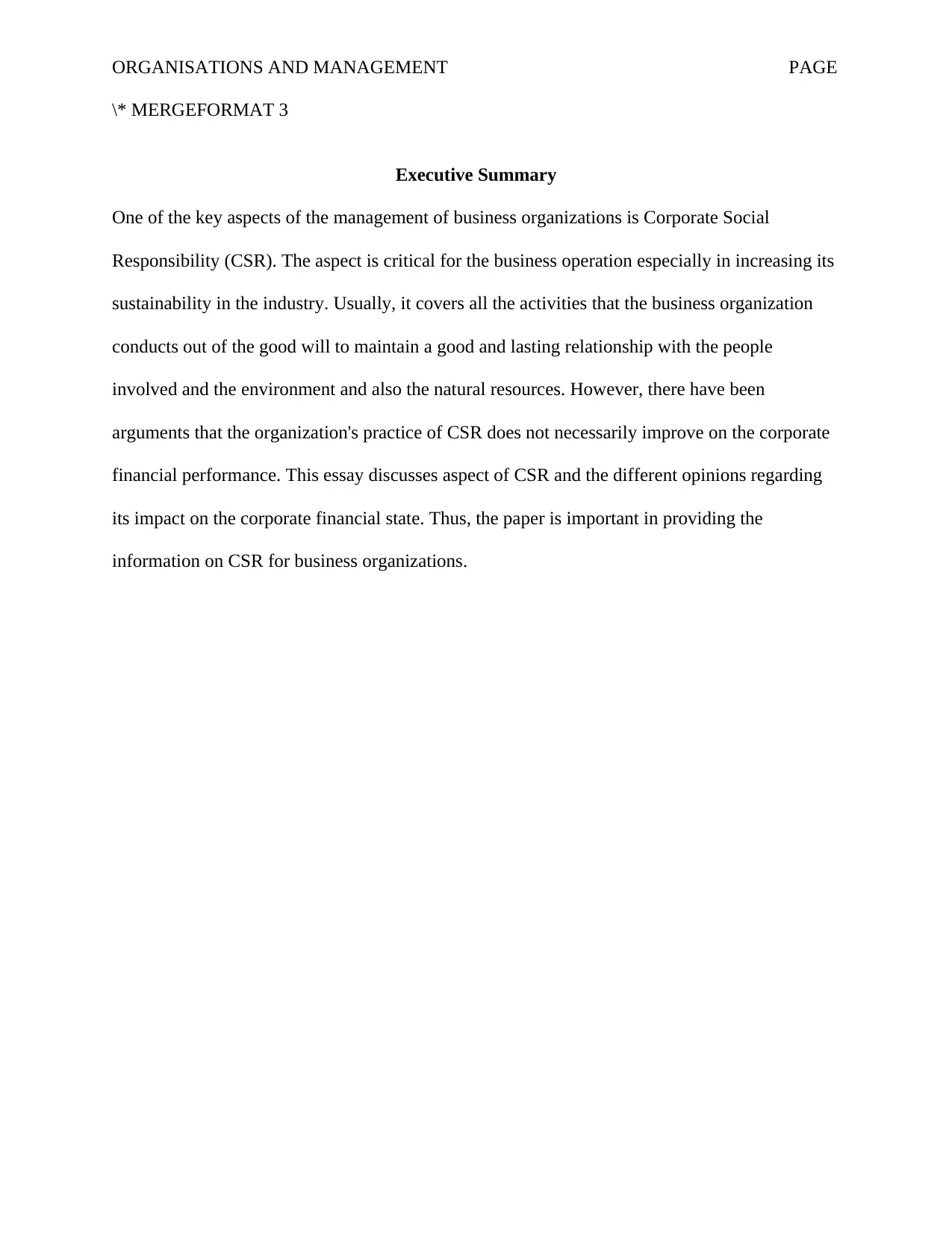
ORGANISATIONS AND MANAGEMENT PAGE
\* MERGEFORMAT 3
Executive Summary
One of the key aspects of the management of business organizations is Corporate Social
Responsibility (CSR). The aspect is critical for the business operation especially in increasing its
sustainability in the industry. Usually, it covers all the activities that the business organization
conducts out of the good will to maintain a good and lasting relationship with the people
involved and the environment and also the natural resources. However, there have been
arguments that the organization's practice of CSR does not necessarily improve on the corporate
financial performance. This essay discusses aspect of CSR and the different opinions regarding
its impact on the corporate financial state. Thus, the paper is important in providing the
information on CSR for business organizations.
\* MERGEFORMAT 3
Executive Summary
One of the key aspects of the management of business organizations is Corporate Social
Responsibility (CSR). The aspect is critical for the business operation especially in increasing its
sustainability in the industry. Usually, it covers all the activities that the business organization
conducts out of the good will to maintain a good and lasting relationship with the people
involved and the environment and also the natural resources. However, there have been
arguments that the organization's practice of CSR does not necessarily improve on the corporate
financial performance. This essay discusses aspect of CSR and the different opinions regarding
its impact on the corporate financial state. Thus, the paper is important in providing the
information on CSR for business organizations.
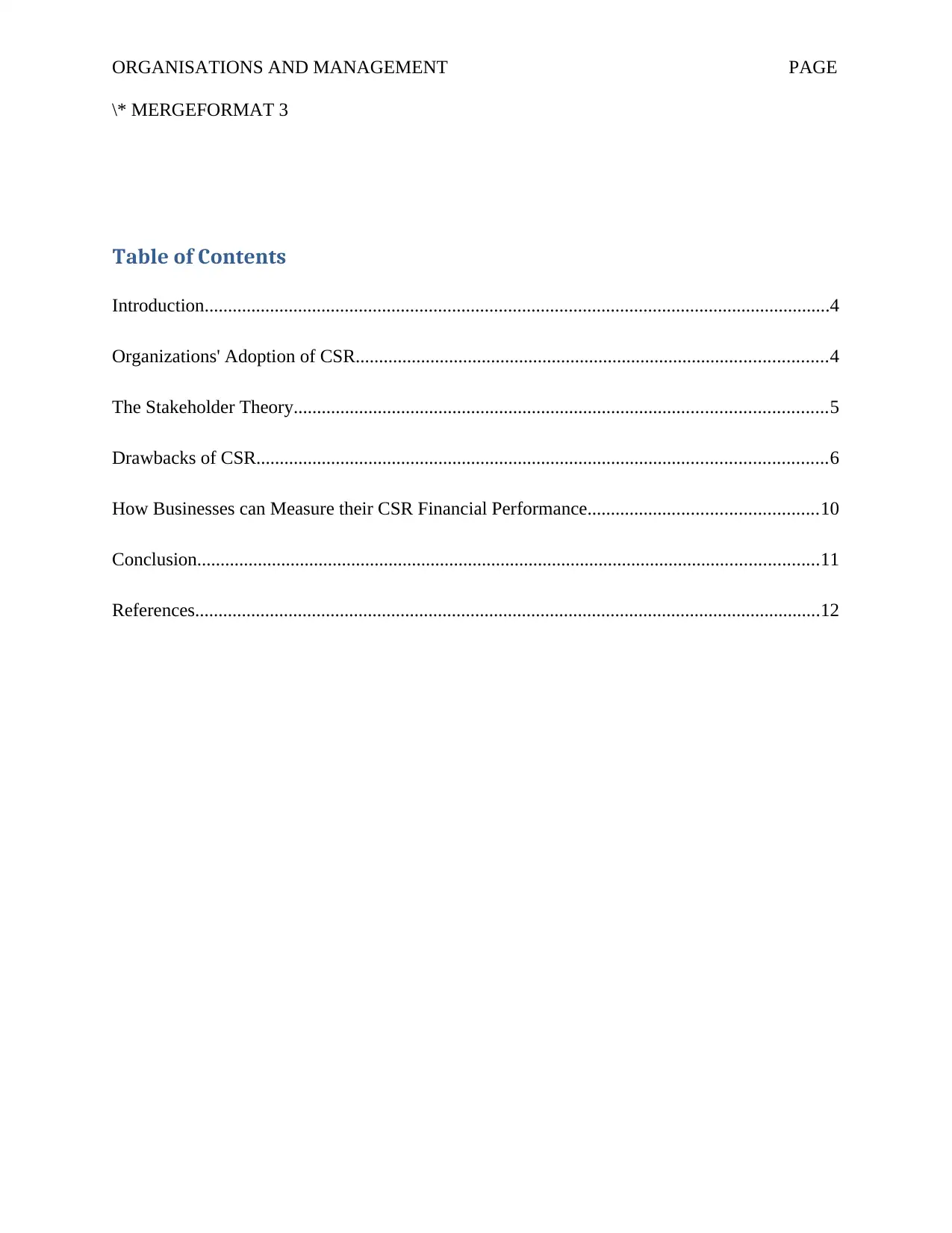
ORGANISATIONS AND MANAGEMENT PAGE
\* MERGEFORMAT 3
Table of Contents
Introduction......................................................................................................................................4
Organizations' Adoption of CSR.....................................................................................................4
The Stakeholder Theory..................................................................................................................5
Drawbacks of CSR..........................................................................................................................6
How Businesses can Measure their CSR Financial Performance.................................................10
Conclusion.....................................................................................................................................11
References......................................................................................................................................12
\* MERGEFORMAT 3
Table of Contents
Introduction......................................................................................................................................4
Organizations' Adoption of CSR.....................................................................................................4
The Stakeholder Theory..................................................................................................................5
Drawbacks of CSR..........................................................................................................................6
How Businesses can Measure their CSR Financial Performance.................................................10
Conclusion.....................................................................................................................................11
References......................................................................................................................................12
⊘ This is a preview!⊘
Do you want full access?
Subscribe today to unlock all pages.

Trusted by 1+ million students worldwide
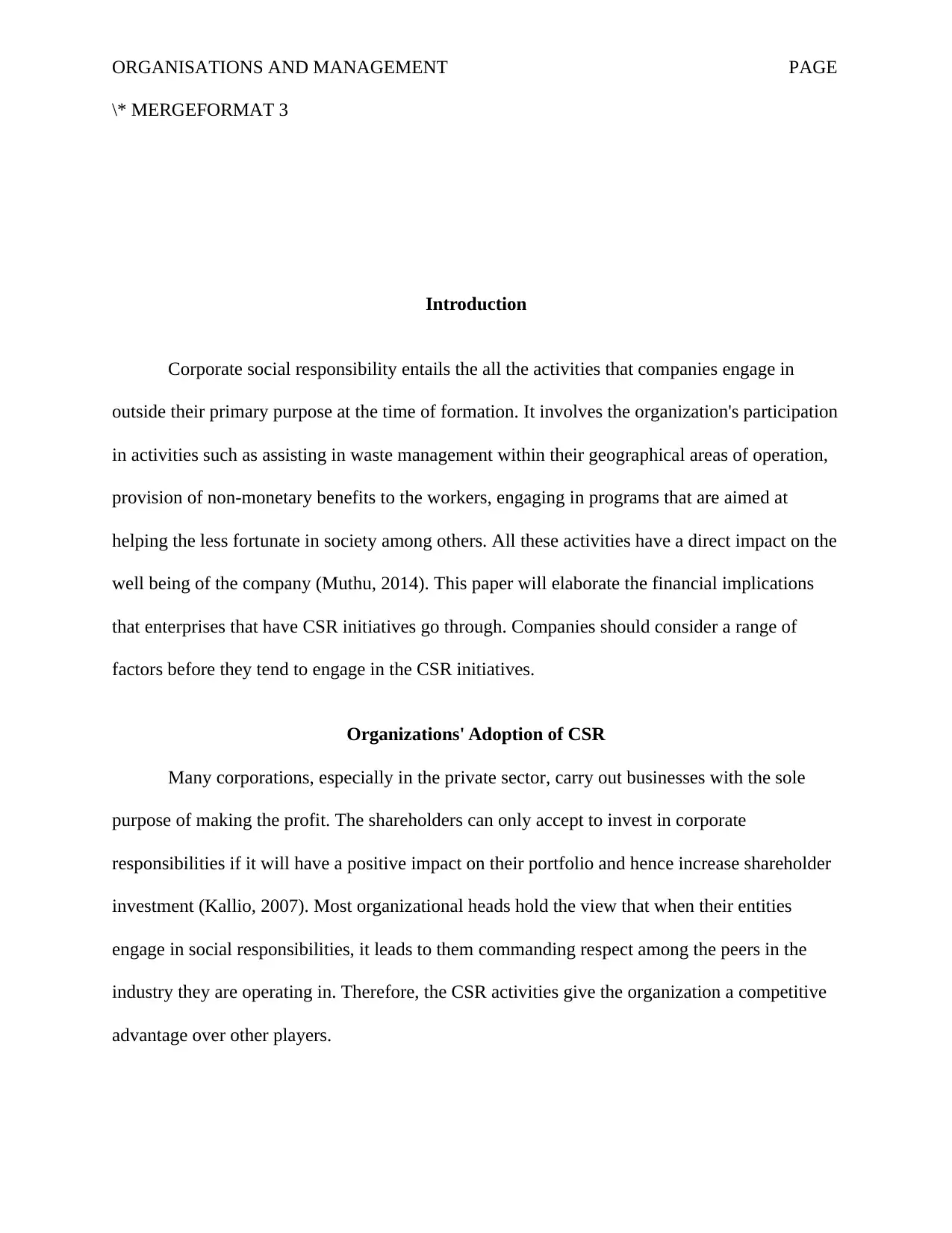
ORGANISATIONS AND MANAGEMENT PAGE
\* MERGEFORMAT 3
Introduction
Corporate social responsibility entails the all the activities that companies engage in
outside their primary purpose at the time of formation. It involves the organization's participation
in activities such as assisting in waste management within their geographical areas of operation,
provision of non-monetary benefits to the workers, engaging in programs that are aimed at
helping the less fortunate in society among others. All these activities have a direct impact on the
well being of the company (Muthu, 2014). This paper will elaborate the financial implications
that enterprises that have CSR initiatives go through. Companies should consider a range of
factors before they tend to engage in the CSR initiatives.
Organizations' Adoption of CSR
Many corporations, especially in the private sector, carry out businesses with the sole
purpose of making the profit. The shareholders can only accept to invest in corporate
responsibilities if it will have a positive impact on their portfolio and hence increase shareholder
investment (Kallio, 2007). Most organizational heads hold the view that when their entities
engage in social responsibilities, it leads to them commanding respect among the peers in the
industry they are operating in. Therefore, the CSR activities give the organization a competitive
advantage over other players.
\* MERGEFORMAT 3
Introduction
Corporate social responsibility entails the all the activities that companies engage in
outside their primary purpose at the time of formation. It involves the organization's participation
in activities such as assisting in waste management within their geographical areas of operation,
provision of non-monetary benefits to the workers, engaging in programs that are aimed at
helping the less fortunate in society among others. All these activities have a direct impact on the
well being of the company (Muthu, 2014). This paper will elaborate the financial implications
that enterprises that have CSR initiatives go through. Companies should consider a range of
factors before they tend to engage in the CSR initiatives.
Organizations' Adoption of CSR
Many corporations, especially in the private sector, carry out businesses with the sole
purpose of making the profit. The shareholders can only accept to invest in corporate
responsibilities if it will have a positive impact on their portfolio and hence increase shareholder
investment (Kallio, 2007). Most organizational heads hold the view that when their entities
engage in social responsibilities, it leads to them commanding respect among the peers in the
industry they are operating in. Therefore, the CSR activities give the organization a competitive
advantage over other players.
Paraphrase This Document
Need a fresh take? Get an instant paraphrase of this document with our AI Paraphraser
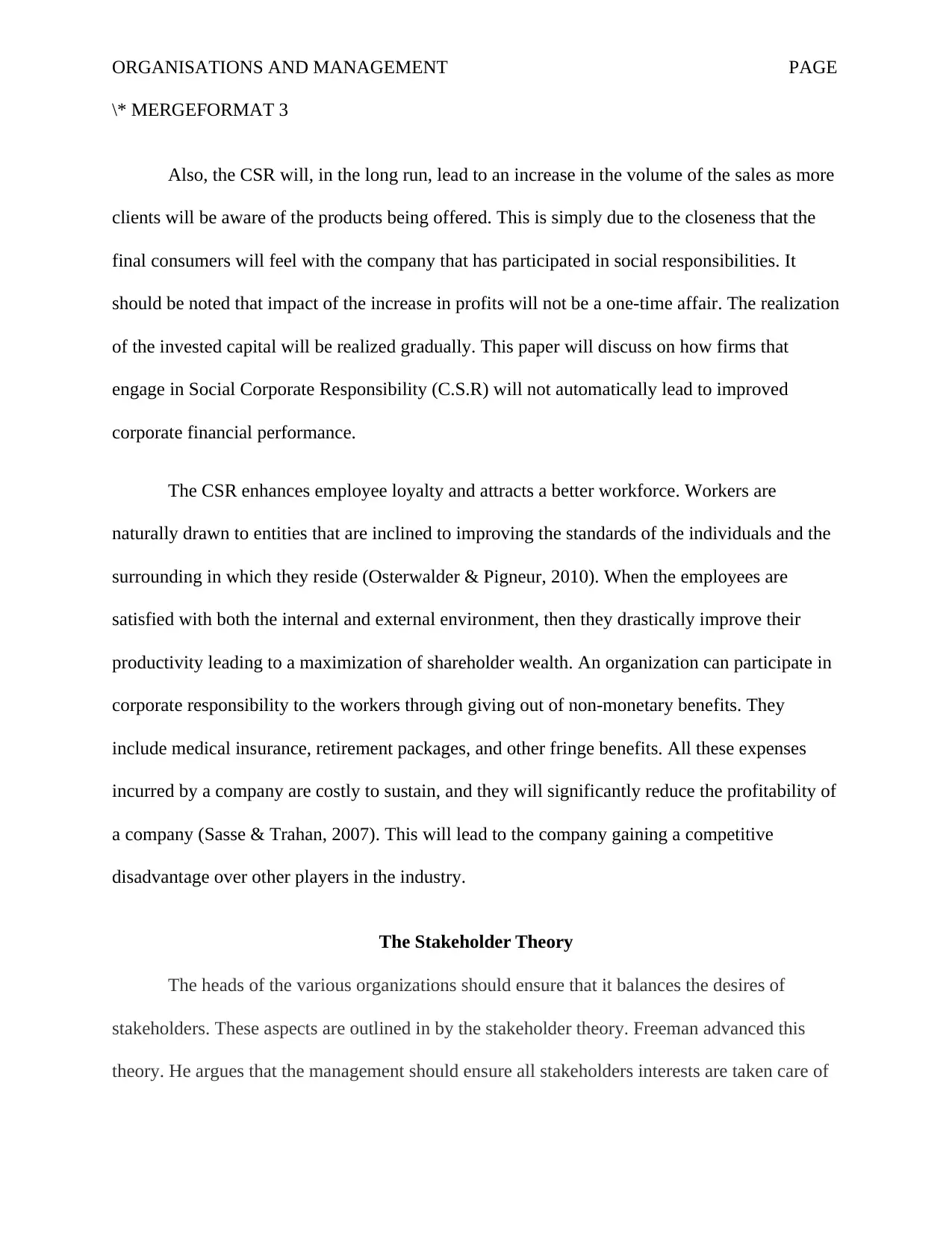
ORGANISATIONS AND MANAGEMENT PAGE
\* MERGEFORMAT 3
Also, the CSR will, in the long run, lead to an increase in the volume of the sales as more
clients will be aware of the products being offered. This is simply due to the closeness that the
final consumers will feel with the company that has participated in social responsibilities. It
should be noted that impact of the increase in profits will not be a one-time affair. The realization
of the invested capital will be realized gradually. This paper will discuss on how firms that
engage in Social Corporate Responsibility (C.S.R) will not automatically lead to improved
corporate financial performance.
The CSR enhances employee loyalty and attracts a better workforce. Workers are
naturally drawn to entities that are inclined to improving the standards of the individuals and the
surrounding in which they reside (Osterwalder & Pigneur, 2010). When the employees are
satisfied with both the internal and external environment, then they drastically improve their
productivity leading to a maximization of shareholder wealth. An organization can participate in
corporate responsibility to the workers through giving out of non-monetary benefits. They
include medical insurance, retirement packages, and other fringe benefits. All these expenses
incurred by a company are costly to sustain, and they will significantly reduce the profitability of
a company (Sasse & Trahan, 2007). This will lead to the company gaining a competitive
disadvantage over other players in the industry.
The Stakeholder Theory
The heads of the various organizations should ensure that it balances the desires of
stakeholders. These aspects are outlined in by the stakeholder theory. Freeman advanced this
theory. He argues that the management should ensure all stakeholders interests are taken care of
\* MERGEFORMAT 3
Also, the CSR will, in the long run, lead to an increase in the volume of the sales as more
clients will be aware of the products being offered. This is simply due to the closeness that the
final consumers will feel with the company that has participated in social responsibilities. It
should be noted that impact of the increase in profits will not be a one-time affair. The realization
of the invested capital will be realized gradually. This paper will discuss on how firms that
engage in Social Corporate Responsibility (C.S.R) will not automatically lead to improved
corporate financial performance.
The CSR enhances employee loyalty and attracts a better workforce. Workers are
naturally drawn to entities that are inclined to improving the standards of the individuals and the
surrounding in which they reside (Osterwalder & Pigneur, 2010). When the employees are
satisfied with both the internal and external environment, then they drastically improve their
productivity leading to a maximization of shareholder wealth. An organization can participate in
corporate responsibility to the workers through giving out of non-monetary benefits. They
include medical insurance, retirement packages, and other fringe benefits. All these expenses
incurred by a company are costly to sustain, and they will significantly reduce the profitability of
a company (Sasse & Trahan, 2007). This will lead to the company gaining a competitive
disadvantage over other players in the industry.
The Stakeholder Theory
The heads of the various organizations should ensure that it balances the desires of
stakeholders. These aspects are outlined in by the stakeholder theory. Freeman advanced this
theory. He argues that the management should ensure all stakeholders interests are taken care of
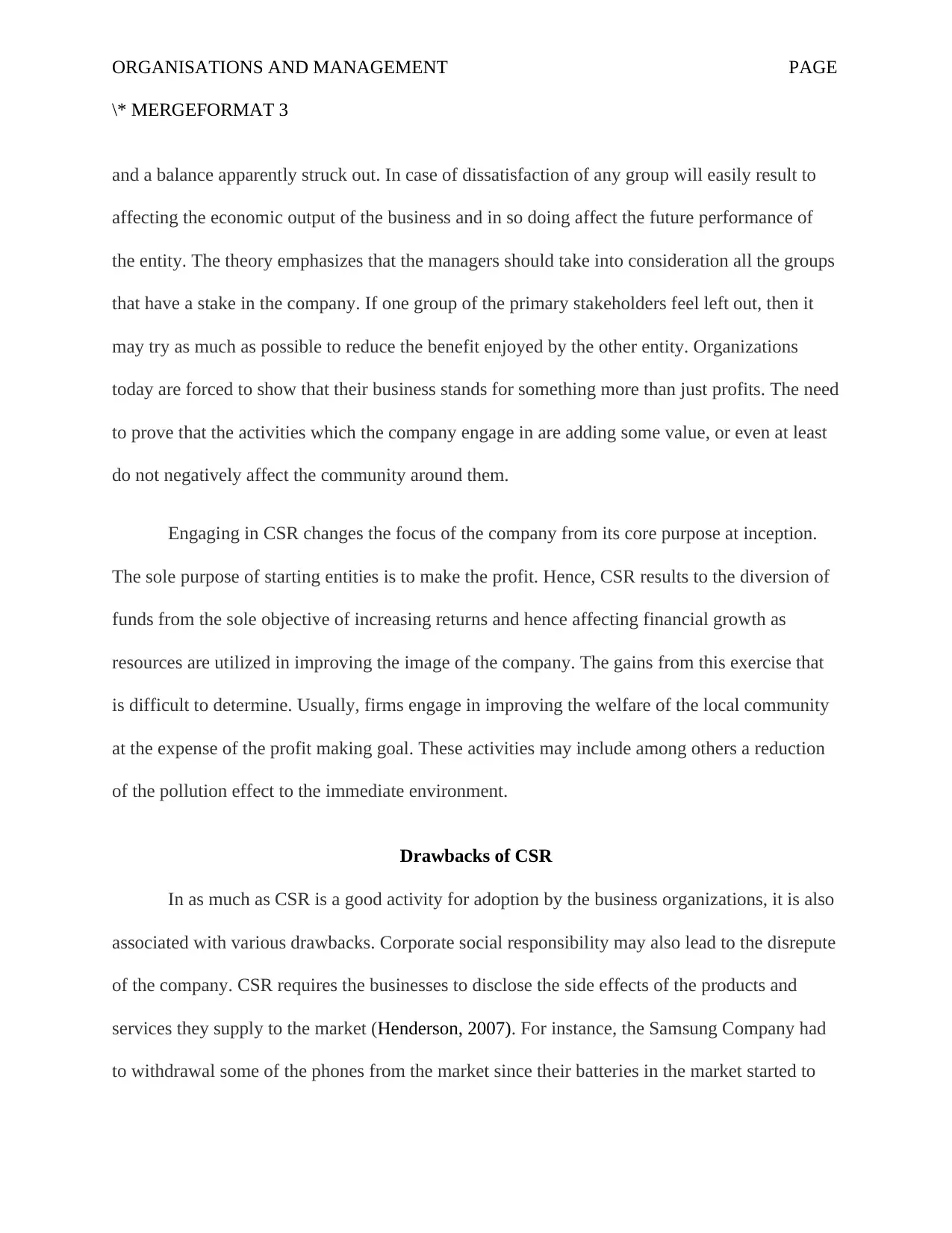
ORGANISATIONS AND MANAGEMENT PAGE
\* MERGEFORMAT 3
and a balance apparently struck out. In case of dissatisfaction of any group will easily result to
affecting the economic output of the business and in so doing affect the future performance of
the entity. The theory emphasizes that the managers should take into consideration all the groups
that have a stake in the company. If one group of the primary stakeholders feel left out, then it
may try as much as possible to reduce the benefit enjoyed by the other entity. Organizations
today are forced to show that their business stands for something more than just profits. The need
to prove that the activities which the company engage in are adding some value, or even at least
do not negatively affect the community around them.
Engaging in CSR changes the focus of the company from its core purpose at inception.
The sole purpose of starting entities is to make the profit. Hence, CSR results to the diversion of
funds from the sole objective of increasing returns and hence affecting financial growth as
resources are utilized in improving the image of the company. The gains from this exercise that
is difficult to determine. Usually, firms engage in improving the welfare of the local community
at the expense of the profit making goal. These activities may include among others a reduction
of the pollution effect to the immediate environment.
Drawbacks of CSR
In as much as CSR is a good activity for adoption by the business organizations, it is also
associated with various drawbacks. Corporate social responsibility may also lead to the disrepute
of the company. CSR requires the businesses to disclose the side effects of the products and
services they supply to the market (Henderson, 2007). For instance, the Samsung Company had
to withdrawal some of the phones from the market since their batteries in the market started to
\* MERGEFORMAT 3
and a balance apparently struck out. In case of dissatisfaction of any group will easily result to
affecting the economic output of the business and in so doing affect the future performance of
the entity. The theory emphasizes that the managers should take into consideration all the groups
that have a stake in the company. If one group of the primary stakeholders feel left out, then it
may try as much as possible to reduce the benefit enjoyed by the other entity. Organizations
today are forced to show that their business stands for something more than just profits. The need
to prove that the activities which the company engage in are adding some value, or even at least
do not negatively affect the community around them.
Engaging in CSR changes the focus of the company from its core purpose at inception.
The sole purpose of starting entities is to make the profit. Hence, CSR results to the diversion of
funds from the sole objective of increasing returns and hence affecting financial growth as
resources are utilized in improving the image of the company. The gains from this exercise that
is difficult to determine. Usually, firms engage in improving the welfare of the local community
at the expense of the profit making goal. These activities may include among others a reduction
of the pollution effect to the immediate environment.
Drawbacks of CSR
In as much as CSR is a good activity for adoption by the business organizations, it is also
associated with various drawbacks. Corporate social responsibility may also lead to the disrepute
of the company. CSR requires the businesses to disclose the side effects of the products and
services they supply to the market (Henderson, 2007). For instance, the Samsung Company had
to withdrawal some of the phones from the market since their batteries in the market started to
⊘ This is a preview!⊘
Do you want full access?
Subscribe today to unlock all pages.

Trusted by 1+ million students worldwide
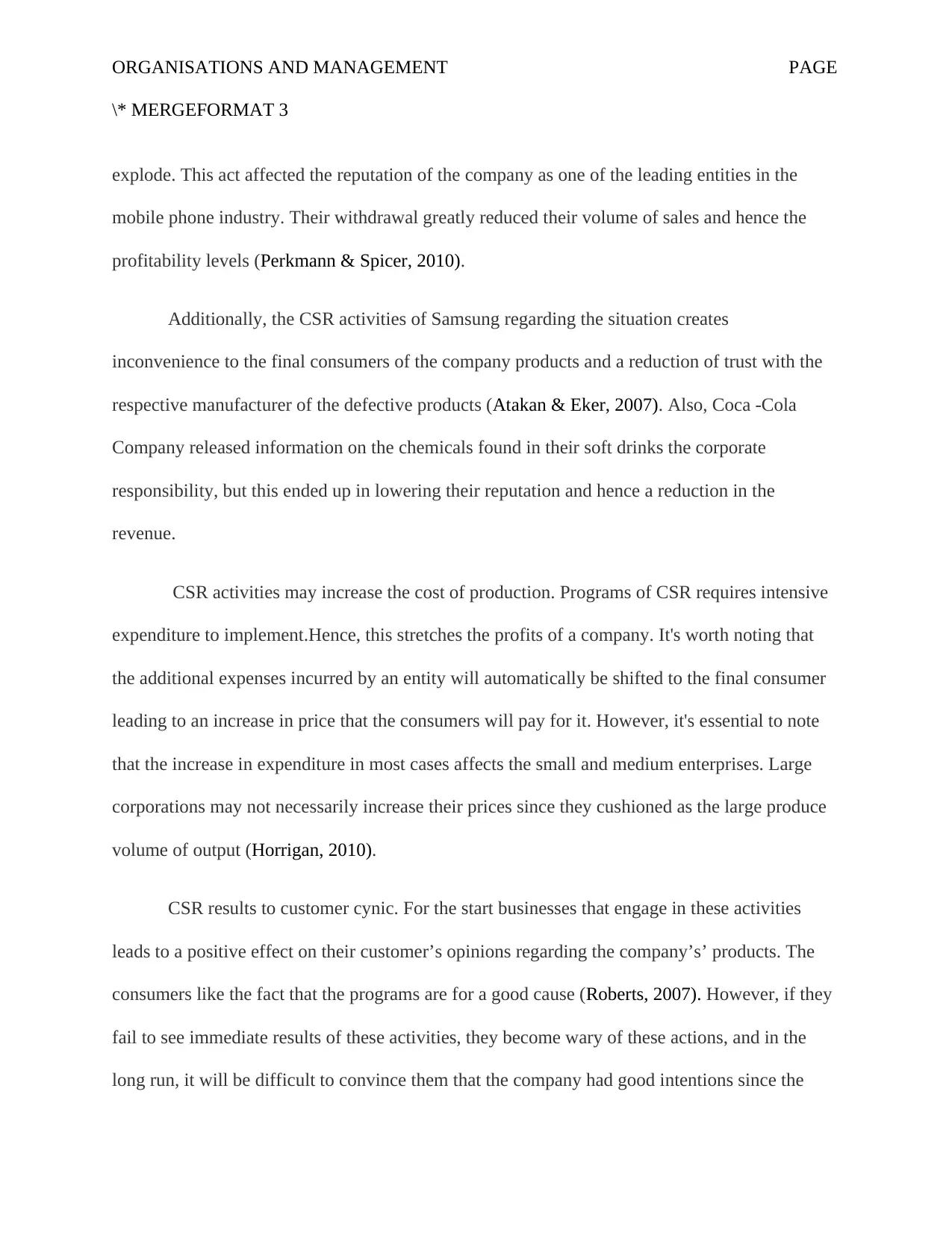
ORGANISATIONS AND MANAGEMENT PAGE
\* MERGEFORMAT 3
explode. This act affected the reputation of the company as one of the leading entities in the
mobile phone industry. Their withdrawal greatly reduced their volume of sales and hence the
profitability levels (Perkmann & Spicer, 2010).
Additionally, the CSR activities of Samsung regarding the situation creates
inconvenience to the final consumers of the company products and a reduction of trust with the
respective manufacturer of the defective products (Atakan & Eker, 2007). Also, Coca -Cola
Company released information on the chemicals found in their soft drinks the corporate
responsibility, but this ended up in lowering their reputation and hence a reduction in the
revenue.
CSR activities may increase the cost of production. Programs of CSR requires intensive
expenditure to implement.Hence, this stretches the profits of a company. It's worth noting that
the additional expenses incurred by an entity will automatically be shifted to the final consumer
leading to an increase in price that the consumers will pay for it. However, it's essential to note
that the increase in expenditure in most cases affects the small and medium enterprises. Large
corporations may not necessarily increase their prices since they cushioned as the large produce
volume of output (Horrigan, 2010).
CSR results to customer cynic. For the start businesses that engage in these activities
leads to a positive effect on their customer’s opinions regarding the company’s’ products. The
consumers like the fact that the programs are for a good cause (Roberts, 2007). However, if they
fail to see immediate results of these activities, they become wary of these actions, and in the
long run, it will be difficult to convince them that the company had good intentions since the
\* MERGEFORMAT 3
explode. This act affected the reputation of the company as one of the leading entities in the
mobile phone industry. Their withdrawal greatly reduced their volume of sales and hence the
profitability levels (Perkmann & Spicer, 2010).
Additionally, the CSR activities of Samsung regarding the situation creates
inconvenience to the final consumers of the company products and a reduction of trust with the
respective manufacturer of the defective products (Atakan & Eker, 2007). Also, Coca -Cola
Company released information on the chemicals found in their soft drinks the corporate
responsibility, but this ended up in lowering their reputation and hence a reduction in the
revenue.
CSR activities may increase the cost of production. Programs of CSR requires intensive
expenditure to implement.Hence, this stretches the profits of a company. It's worth noting that
the additional expenses incurred by an entity will automatically be shifted to the final consumer
leading to an increase in price that the consumers will pay for it. However, it's essential to note
that the increase in expenditure in most cases affects the small and medium enterprises. Large
corporations may not necessarily increase their prices since they cushioned as the large produce
volume of output (Horrigan, 2010).
CSR results to customer cynic. For the start businesses that engage in these activities
leads to a positive effect on their customer’s opinions regarding the company’s’ products. The
consumers like the fact that the programs are for a good cause (Roberts, 2007). However, if they
fail to see immediate results of these activities, they become wary of these actions, and in the
long run, it will be difficult to convince them that the company had good intentions since the
Paraphrase This Document
Need a fresh take? Get an instant paraphrase of this document with our AI Paraphraser
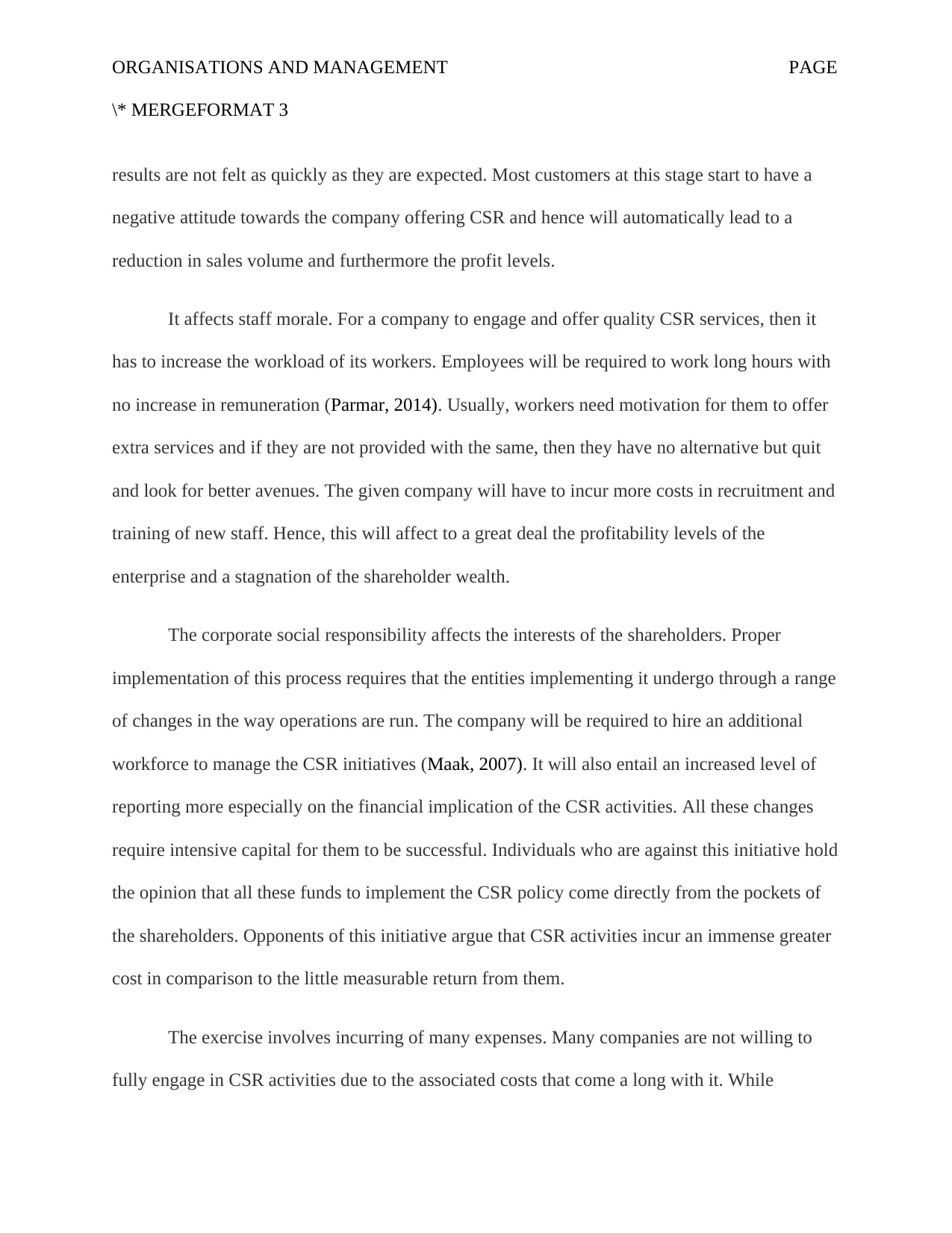
ORGANISATIONS AND MANAGEMENT PAGE
\* MERGEFORMAT 3
results are not felt as quickly as they are expected. Most customers at this stage start to have a
negative attitude towards the company offering CSR and hence will automatically lead to a
reduction in sales volume and furthermore the profit levels.
It affects staff morale. For a company to engage and offer quality CSR services, then it
has to increase the workload of its workers. Employees will be required to work long hours with
no increase in remuneration (Parmar, 2014). Usually, workers need motivation for them to offer
extra services and if they are not provided with the same, then they have no alternative but quit
and look for better avenues. The given company will have to incur more costs in recruitment and
training of new staff. Hence, this will affect to a great deal the profitability levels of the
enterprise and a stagnation of the shareholder wealth.
The corporate social responsibility affects the interests of the shareholders. Proper
implementation of this process requires that the entities implementing it undergo through a range
of changes in the way operations are run. The company will be required to hire an additional
workforce to manage the CSR initiatives (Maak, 2007). It will also entail an increased level of
reporting more especially on the financial implication of the CSR activities. All these changes
require intensive capital for them to be successful. Individuals who are against this initiative hold
the opinion that all these funds to implement the CSR policy come directly from the pockets of
the shareholders. Opponents of this initiative argue that CSR activities incur an immense greater
cost in comparison to the little measurable return from them.
The exercise involves incurring of many expenses. Many companies are not willing to
fully engage in CSR activities due to the associated costs that come a long with it. While
\* MERGEFORMAT 3
results are not felt as quickly as they are expected. Most customers at this stage start to have a
negative attitude towards the company offering CSR and hence will automatically lead to a
reduction in sales volume and furthermore the profit levels.
It affects staff morale. For a company to engage and offer quality CSR services, then it
has to increase the workload of its workers. Employees will be required to work long hours with
no increase in remuneration (Parmar, 2014). Usually, workers need motivation for them to offer
extra services and if they are not provided with the same, then they have no alternative but quit
and look for better avenues. The given company will have to incur more costs in recruitment and
training of new staff. Hence, this will affect to a great deal the profitability levels of the
enterprise and a stagnation of the shareholder wealth.
The corporate social responsibility affects the interests of the shareholders. Proper
implementation of this process requires that the entities implementing it undergo through a range
of changes in the way operations are run. The company will be required to hire an additional
workforce to manage the CSR initiatives (Maak, 2007). It will also entail an increased level of
reporting more especially on the financial implication of the CSR activities. All these changes
require intensive capital for them to be successful. Individuals who are against this initiative hold
the opinion that all these funds to implement the CSR policy come directly from the pockets of
the shareholders. Opponents of this initiative argue that CSR activities incur an immense greater
cost in comparison to the little measurable return from them.
The exercise involves incurring of many expenses. Many companies are not willing to
fully engage in CSR activities due to the associated costs that come a long with it. While
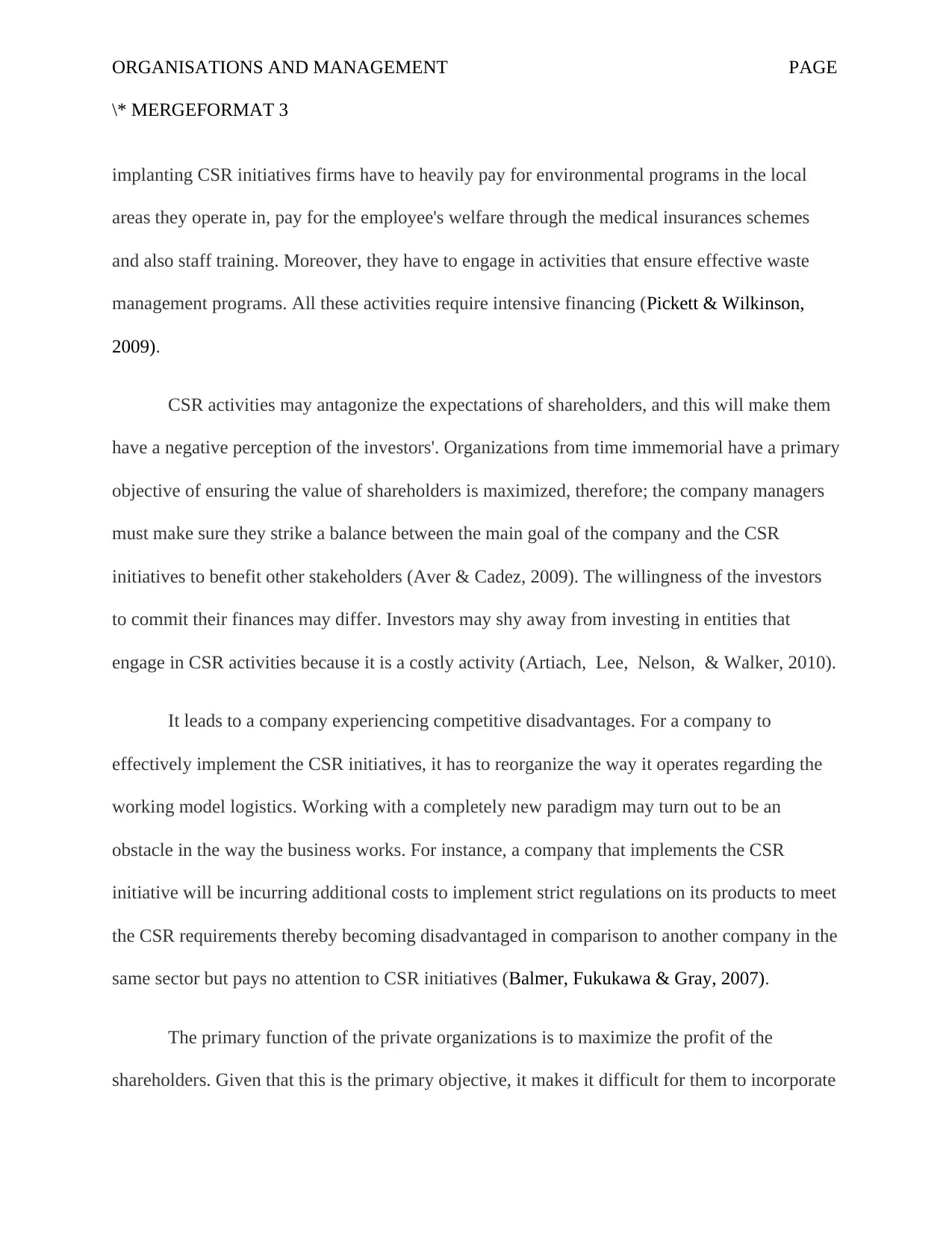
ORGANISATIONS AND MANAGEMENT PAGE
\* MERGEFORMAT 3
implanting CSR initiatives firms have to heavily pay for environmental programs in the local
areas they operate in, pay for the employee's welfare through the medical insurances schemes
and also staff training. Moreover, they have to engage in activities that ensure effective waste
management programs. All these activities require intensive financing (Pickett & Wilkinson,
2009).
CSR activities may antagonize the expectations of shareholders, and this will make them
have a negative perception of the investors'. Organizations from time immemorial have a primary
objective of ensuring the value of shareholders is maximized, therefore; the company managers
must make sure they strike a balance between the main goal of the company and the CSR
initiatives to benefit other stakeholders (Aver & Cadez, 2009). The willingness of the investors
to commit their finances may differ. Investors may shy away from investing in entities that
engage in CSR activities because it is a costly activity (Artiach, Lee, Nelson, & Walker, 2010).
It leads to a company experiencing competitive disadvantages. For a company to
effectively implement the CSR initiatives, it has to reorganize the way it operates regarding the
working model logistics. Working with a completely new paradigm may turn out to be an
obstacle in the way the business works. For instance, a company that implements the CSR
initiative will be incurring additional costs to implement strict regulations on its products to meet
the CSR requirements thereby becoming disadvantaged in comparison to another company in the
same sector but pays no attention to CSR initiatives (Balmer, Fukukawa & Gray, 2007).
The primary function of the private organizations is to maximize the profit of the
shareholders. Given that this is the primary objective, it makes it difficult for them to incorporate
\* MERGEFORMAT 3
implanting CSR initiatives firms have to heavily pay for environmental programs in the local
areas they operate in, pay for the employee's welfare through the medical insurances schemes
and also staff training. Moreover, they have to engage in activities that ensure effective waste
management programs. All these activities require intensive financing (Pickett & Wilkinson,
2009).
CSR activities may antagonize the expectations of shareholders, and this will make them
have a negative perception of the investors'. Organizations from time immemorial have a primary
objective of ensuring the value of shareholders is maximized, therefore; the company managers
must make sure they strike a balance between the main goal of the company and the CSR
initiatives to benefit other stakeholders (Aver & Cadez, 2009). The willingness of the investors
to commit their finances may differ. Investors may shy away from investing in entities that
engage in CSR activities because it is a costly activity (Artiach, Lee, Nelson, & Walker, 2010).
It leads to a company experiencing competitive disadvantages. For a company to
effectively implement the CSR initiatives, it has to reorganize the way it operates regarding the
working model logistics. Working with a completely new paradigm may turn out to be an
obstacle in the way the business works. For instance, a company that implements the CSR
initiative will be incurring additional costs to implement strict regulations on its products to meet
the CSR requirements thereby becoming disadvantaged in comparison to another company in the
same sector but pays no attention to CSR initiatives (Balmer, Fukukawa & Gray, 2007).
The primary function of the private organizations is to maximize the profit of the
shareholders. Given that this is the primary objective, it makes it difficult for them to incorporate
⊘ This is a preview!⊘
Do you want full access?
Subscribe today to unlock all pages.

Trusted by 1+ million students worldwide
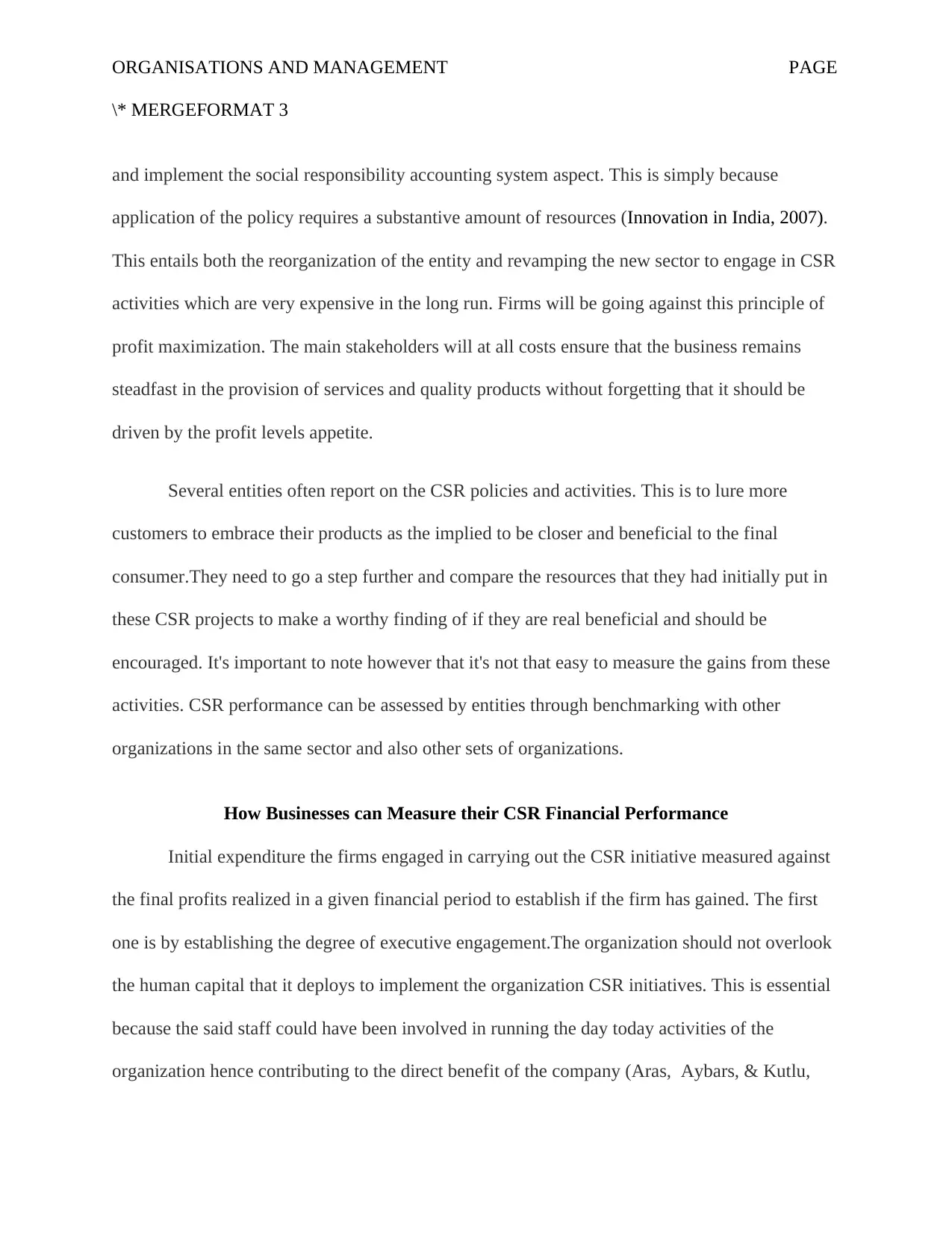
ORGANISATIONS AND MANAGEMENT PAGE
\* MERGEFORMAT 3
and implement the social responsibility accounting system aspect. This is simply because
application of the policy requires a substantive amount of resources (Innovation in India, 2007).
This entails both the reorganization of the entity and revamping the new sector to engage in CSR
activities which are very expensive in the long run. Firms will be going against this principle of
profit maximization. The main stakeholders will at all costs ensure that the business remains
steadfast in the provision of services and quality products without forgetting that it should be
driven by the profit levels appetite.
Several entities often report on the CSR policies and activities. This is to lure more
customers to embrace their products as the implied to be closer and beneficial to the final
consumer.They need to go a step further and compare the resources that they had initially put in
these CSR projects to make a worthy finding of if they are real beneficial and should be
encouraged. It's important to note however that it's not that easy to measure the gains from these
activities. CSR performance can be assessed by entities through benchmarking with other
organizations in the same sector and also other sets of organizations.
How Businesses can Measure their CSR Financial Performance
Initial expenditure the firms engaged in carrying out the CSR initiative measured against
the final profits realized in a given financial period to establish if the firm has gained. The first
one is by establishing the degree of executive engagement.The organization should not overlook
the human capital that it deploys to implement the organization CSR initiatives. This is essential
because the said staff could have been involved in running the day today activities of the
organization hence contributing to the direct benefit of the company (Aras, Aybars, & Kutlu,
\* MERGEFORMAT 3
and implement the social responsibility accounting system aspect. This is simply because
application of the policy requires a substantive amount of resources (Innovation in India, 2007).
This entails both the reorganization of the entity and revamping the new sector to engage in CSR
activities which are very expensive in the long run. Firms will be going against this principle of
profit maximization. The main stakeholders will at all costs ensure that the business remains
steadfast in the provision of services and quality products without forgetting that it should be
driven by the profit levels appetite.
Several entities often report on the CSR policies and activities. This is to lure more
customers to embrace their products as the implied to be closer and beneficial to the final
consumer.They need to go a step further and compare the resources that they had initially put in
these CSR projects to make a worthy finding of if they are real beneficial and should be
encouraged. It's important to note however that it's not that easy to measure the gains from these
activities. CSR performance can be assessed by entities through benchmarking with other
organizations in the same sector and also other sets of organizations.
How Businesses can Measure their CSR Financial Performance
Initial expenditure the firms engaged in carrying out the CSR initiative measured against
the final profits realized in a given financial period to establish if the firm has gained. The first
one is by establishing the degree of executive engagement.The organization should not overlook
the human capital that it deploys to implement the organization CSR initiatives. This is essential
because the said staff could have been involved in running the day today activities of the
organization hence contributing to the direct benefit of the company (Aras, Aybars, & Kutlu,
Paraphrase This Document
Need a fresh take? Get an instant paraphrase of this document with our AI Paraphraser
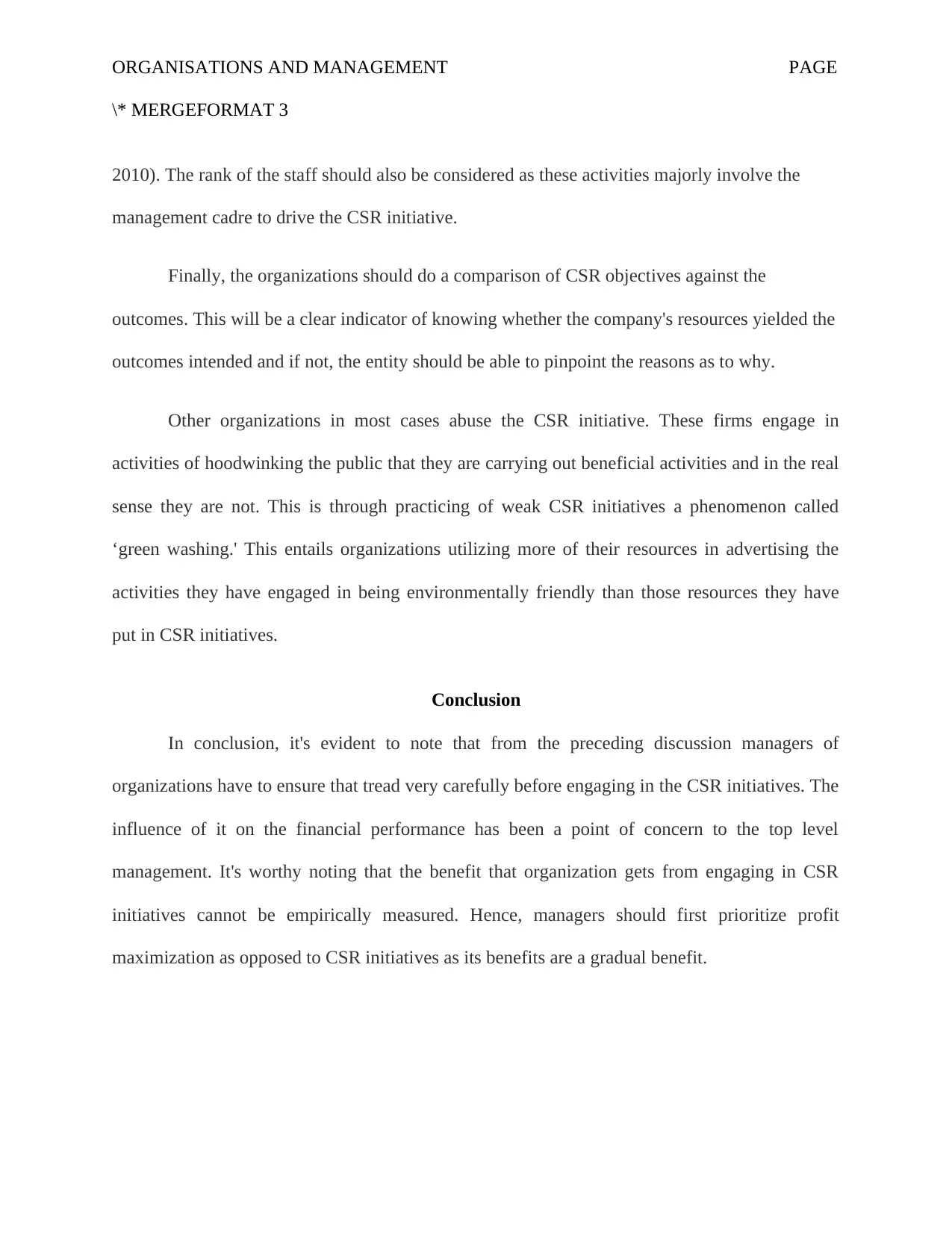
ORGANISATIONS AND MANAGEMENT PAGE
\* MERGEFORMAT 3
2010). The rank of the staff should also be considered as these activities majorly involve the
management cadre to drive the CSR initiative.
Finally, the organizations should do a comparison of CSR objectives against the
outcomes. This will be a clear indicator of knowing whether the company's resources yielded the
outcomes intended and if not, the entity should be able to pinpoint the reasons as to why.
Other organizations in most cases abuse the CSR initiative. These firms engage in
activities of hoodwinking the public that they are carrying out beneficial activities and in the real
sense they are not. This is through practicing of weak CSR initiatives a phenomenon called
‘green washing.' This entails organizations utilizing more of their resources in advertising the
activities they have engaged in being environmentally friendly than those resources they have
put in CSR initiatives.
Conclusion
In conclusion, it's evident to note that from the preceding discussion managers of
organizations have to ensure that tread very carefully before engaging in the CSR initiatives. The
influence of it on the financial performance has been a point of concern to the top level
management. It's worthy noting that the benefit that organization gets from engaging in CSR
initiatives cannot be empirically measured. Hence, managers should first prioritize profit
maximization as opposed to CSR initiatives as its benefits are a gradual benefit.
\* MERGEFORMAT 3
2010). The rank of the staff should also be considered as these activities majorly involve the
management cadre to drive the CSR initiative.
Finally, the organizations should do a comparison of CSR objectives against the
outcomes. This will be a clear indicator of knowing whether the company's resources yielded the
outcomes intended and if not, the entity should be able to pinpoint the reasons as to why.
Other organizations in most cases abuse the CSR initiative. These firms engage in
activities of hoodwinking the public that they are carrying out beneficial activities and in the real
sense they are not. This is through practicing of weak CSR initiatives a phenomenon called
‘green washing.' This entails organizations utilizing more of their resources in advertising the
activities they have engaged in being environmentally friendly than those resources they have
put in CSR initiatives.
Conclusion
In conclusion, it's evident to note that from the preceding discussion managers of
organizations have to ensure that tread very carefully before engaging in the CSR initiatives. The
influence of it on the financial performance has been a point of concern to the top level
management. It's worthy noting that the benefit that organization gets from engaging in CSR
initiatives cannot be empirically measured. Hence, managers should first prioritize profit
maximization as opposed to CSR initiatives as its benefits are a gradual benefit.
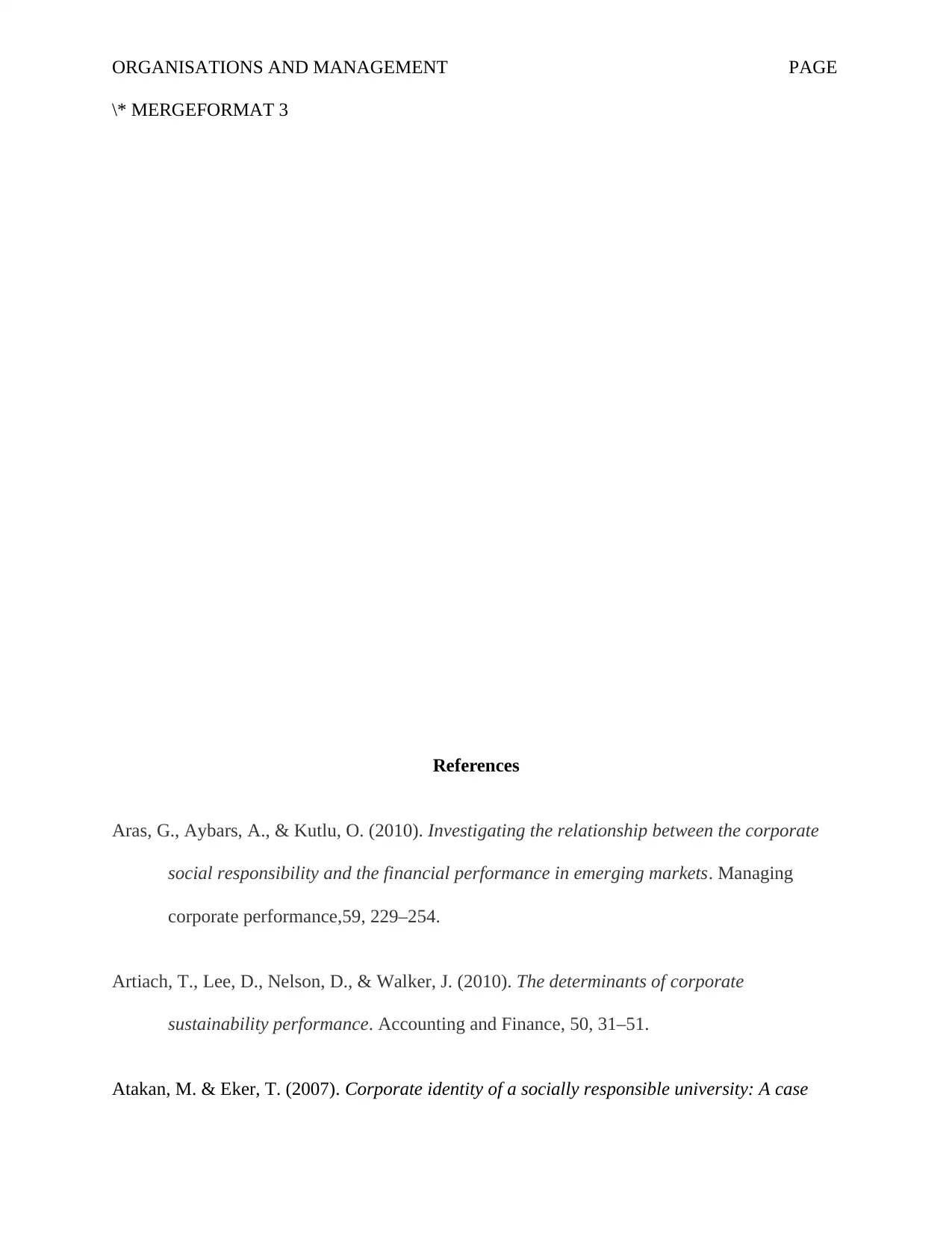
ORGANISATIONS AND MANAGEMENT PAGE
\* MERGEFORMAT 3
References
Aras, G., Aybars, A., & Kutlu, O. (2010). Investigating the relationship between the corporate
social responsibility and the financial performance in emerging markets. Managing
corporate performance,59, 229–254.
Artiach, T., Lee, D., Nelson, D., & Walker, J. (2010). The determinants of corporate
sustainability performance. Accounting and Finance, 50, 31–51.
Atakan, M. & Eker, T. (2007). Corporate identity of a socially responsible university: A case
\* MERGEFORMAT 3
References
Aras, G., Aybars, A., & Kutlu, O. (2010). Investigating the relationship between the corporate
social responsibility and the financial performance in emerging markets. Managing
corporate performance,59, 229–254.
Artiach, T., Lee, D., Nelson, D., & Walker, J. (2010). The determinants of corporate
sustainability performance. Accounting and Finance, 50, 31–51.
Atakan, M. & Eker, T. (2007). Corporate identity of a socially responsible university: A case
⊘ This is a preview!⊘
Do you want full access?
Subscribe today to unlock all pages.

Trusted by 1+ million students worldwide
1 out of 13
Related Documents
Your All-in-One AI-Powered Toolkit for Academic Success.
+13062052269
info@desklib.com
Available 24*7 on WhatsApp / Email
![[object Object]](/_next/static/media/star-bottom.7253800d.svg)
Unlock your academic potential
Copyright © 2020–2025 A2Z Services. All Rights Reserved. Developed and managed by ZUCOL.




